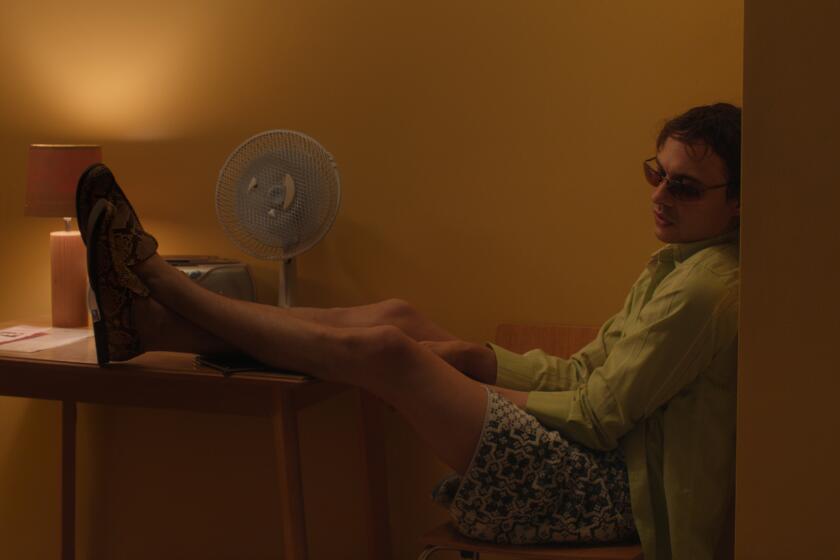Under the influences
- Share via
The key to Richard Prince’s current exhibition at Regen Projects is in the title: “Women.” The artist excels in capturing the iconic, so his subjects are not average or even believable women. There are photographs of Raquel Welch in a fur bikini, a prepubescent Brooke Shields and a baby-faced blond with a motorcycle. There are women represented in publicity stills, magazine advertisements, book covers and Borscht Belt jokes. On a large, creamy canvas, a joke is lettered: “Do you know what it means to come home to a woman who’ll give you a little love, a little affection, a little tenderness? It means your in the wrong house. That’s what it means.”
Seductive in every way, these images manifest broadly popular notions and niche views but conscientiously avoid any claim to authenticity. This is the manufactured world of entertainment and cliche with all of its inherent appeal and ability to create anxiety. Prince has constructed a highly successful career on the simple question built into the nature of photography itself: What is real?
The images, selected by Prince from his own collection, are representative of various bodies of work made in the last 25 years. Although his photographs and paintings have been the subject of museum retrospectives, including one at the Whitney Museum of American Art in 1992, Prince has taken a hands-on approach here, serving as his own curator.
Today, Prince, 54, lives a quiet life in upstate New York with his wife, artist Noel Grunewaldt; his daughter, Ella, and stepson Graham. During a recent trip to L.A., Prince explained the concept behind this show: “Women have been a big part of my subject matter since the beginning. It’s not an idea or theory. That was what was there in the media.”
A SoHo art star of the 1980s, Prince initially rose to fame with a group of artists who used photography to examine issues of reproduction -- Cindy Sherman, James Welling and Laurie Simmons. They considered their work different from that produced by other photographers. These 20-ish artists, who came of age in the late ‘70s, were inspired by the dual legacies of conceptual and Pop art.
“The idea of using a medium -- photography -- I had no expertise in appealed to me. You got into a situation because of a lack of skill that couldn’t happen if someone was well-versed in the ability to take pictures,” says Prince, who had a job sorting through tear sheets at the Time-Life office in New York when he hit upon the idea of re-photographing existing photographs and presenting them as his art. “It wouldn’t occur to a real photographer to do what I did if they knew what they were doing. The point being that I didn’t know what I was doing.”
Looking back, he thinks his work had something to do with “trying to tell the truth.”
“What was real wasn’t defined from what was unreal. These are things that you are trying to figure out when you are young. Like the idea of punk rock. You didn’t know how to play a guitar, but you start a band. I did the same thing with a camera. It was more about attitude than practice.”
That attitude has brought Prince fame and prosperity. The Marlboro Man, which he famously re-photographed, recently sold at auction for close to half a million dollars. Prince worked in other media as well. He created “joke” paintings, and, most recently, paintings of the covers of paperback books about nurses. His common theme: issues in popular culture.
From the outset of his career, Prince has produced books of his own writings and those of others. He collects not only books but also manuscripts, noting that he likes to see “the original source material before it is edited.” In “Women,” the book produced to accompany the exhibition, scraps of manuscripts or jokes are the only text apart from a humorous and informative appendix. It extends the theme of his show to include his commission to photograph fashion model Kate Moss to pictures of books by female authors such as Joan Didion and Eve Babitz. Publicity stills signed by celebrity wannabes at a showcase called Glamourcon are given equal space with his Andy Warhol silk-screen of Jacqueline Kennedy. As Prince flips through the pages, a new tangent in his work becomes apparent. There are his photographs of real people -- not appropriations -- including his wife, children and neighborhood.
Prince collects images to use in his art, often taking them from magazines or books. His book documents his more personal role as collector of other people’s art, whether a valuable painting or a poster from the girl bar.
While Prince is collecting the art of others, he has been claimed by art history. Several photographs by Prince are included in “The Last Picture Show: Artists Using Photography, 1960-1982” at the UCLA Hammer Museum. Douglas Fogle, Walker Art Center’s associate curator who organized the exhibition, presents Prince as heir apparent to conceptual artist John Baldessari.
Prince, who has not seen the show, shrugged off the observation. “My influences are more like Bob Dylan, Lenny Bruce, Rod Serling, Orson Welles. These are influences that happen in the ninth grade, things you never forget. To me, it is seeing something someone did and thinking, ‘God, I wish I’d done that.’ That’s an influence.”
*
“Richard Prince: Women”
Where: Regen Projects, 633 N. Almont Drive, Los Angeles
When: Tuesday-Saturday,
10 a.m.-6 p.m.
Ends: March 20
Price: Free
Contact: (310) 276-5424 or www.regenprojects.com
More to Read
The biggest entertainment stories
Get our big stories about Hollywood, film, television, music, arts, culture and more right in your inbox as soon as they publish.
You may occasionally receive promotional content from the Los Angeles Times.










